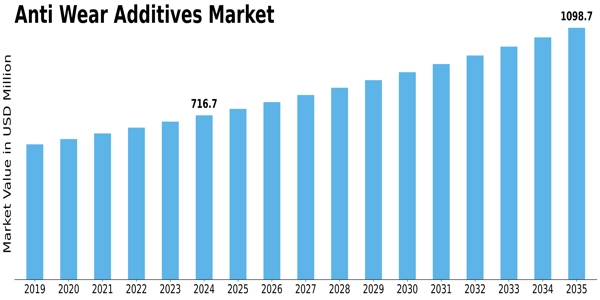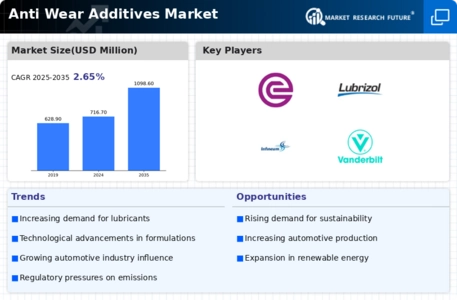Anti Wear Additives Size
Anti Wear Additives Market Growth Projections and Opportunities
Hydraulic fluid is a key substance used to transmit power and provide lubrication in hydraulic systems. This type of fluid plays a crucial role in the drilling operations of crude oil production. The constant increase in crude oil production has led to a growing demand for hydraulic fluid. Additionally, the thriving global automotive industry is a major driver for the demand for hydraulic fluid.
As of 2016, the global hydraulic fluid market was valued at USD 3.64 million, and it is estimated to reach USD 4.31 million by 2023, growing at a Compound Annual Growth Rate (CAGR) of 2.57%. The market is categorized into three main types: petroleum-based, bio-based, and fire-resistant. Among these, petroleum-based hydraulic fluid holds the largest market share, accounting for more than 72%, followed by bio-based fluid at 23% in 2016.
The market is further segmented based on end-user industries, including oil and gas, automotive, marine, aircraft, industrial machinery, construction, and others. Among these, the oil and gas industry is the largest segment, holding a market share of over 38%. It is anticipated to maintain its dominance during the forecast period, followed by the automotive industry with a share of 21%.
The primary purpose of hydraulic fluid is to transmit power efficiently within hydraulic systems. In the context of crude oil production, hydraulic fluids are essential for the drilling operations. The consistent growth in crude oil production has led to an increased demand for hydraulic fluid in this sector. The fluid facilitates the smooth operation of hydraulic systems by providing lubrication and ensuring efficient power transmission.
Furthermore, the global automotive industry is a significant contributor to the demand for hydraulic fluid. In various automotive applications, hydraulic systems are employed for tasks such as power steering and braking. The reliable and efficient performance of these systems depends on the quality and functionality of the hydraulic fluid used. As the automotive industry continues to flourish globally, the demand for hydraulic fluid is expected to grow in tandem.
According to analysis by MRFR (Market Research Future), the global hydraulic fluid market has been on an upward trajectory. In 2016, the market was valued at USD 3.64 million, and it is projected to reach USD 4.31 million by 2023. This indicates a steady expansion with a Compound Annual Growth Rate (CAGR) of 2.57%. The petroleum-based hydraulic fluid dominates the market, holding a significant market share of more than 72% in 2016. Bio-based hydraulic fluid is the second-largest segment with a share of 23%.
The market segmentation based on end-user industries provides insights into the diverse applications of hydraulic fluid. The oil and gas industry stands out as the largest consumer, with a market share exceeding 38%. This industry is expected to maintain its dominance in the foreseeable future. Following closely is the automotive industry, contributing significantly with a market share of 21%.
In conclusion, hydraulic fluid plays a crucial role in power transmission and lubrication in hydraulic systems, particularly in the drilling operations of crude oil production. The growing demand in both the oil and gas industry and the automotive sector is propelling the expansion of the global hydraulic fluid market, with petroleum-based fluid leading the market. The future outlook suggests a continued upward trend, driven by the sustained growth of these key industries.
















Leave a Comment